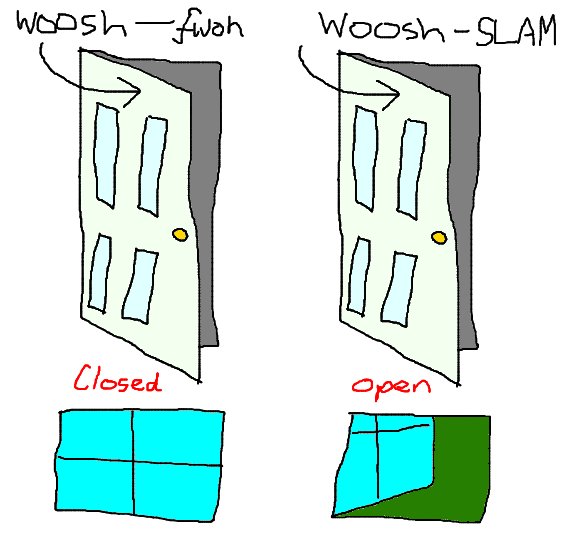
Doors can be quirky, often responding to their environment in ways we don’t expect. Picture a door like a person in a crowded room, easily influenced by the movements of those around them. In this case, there can be several factors causing your door to act up, from its physical condition to environmental changes. Let’s dive into the reasons behind this phenomenon and create a simple diagnostic flowchart to help you figure it out.
Understanding Door Mechanics
To get a grip on why your door might swing open or closed on its own, it’s important to understand a bit about door mechanics. At its core, a door is held by hinges, which allow it to pivot. If those hinges are loose, or if the door isn’t aligned properly, it can swing in ways you might not want.
Picture a well-balanced seesaw in a playground. If one side is heavier, it tips. Similarly, if your door isn’t balanced, it can lean toward one side or swing freely. Other factors, like the door’s weight and its frame’s condition, also come into play. So, a door that isn’t hung right or is damaged could lead to spontaneous swinging.
Common Causes of Doors Swinging Open/Closed
Now let’s break down the typical reasons behind this door dilemma. They may seem straightforward, but understanding the underlying causes can save you a lot of time and frustration.
- Loose Hinges: If your hinges are not tightened properly, they can cause the door to move unexpectedly.
- Door Warping: Changes in humidity can warp wooden doors, leading them to sway.
- Improper Installation: If the door wasn’t installed correctly, it might not sit flush in the frame.
- Airflow: Strong winds or drafts can push a door open or closed.
It’s worth checking each of these factors when diagnosing your door’s behavior. For example, if the hinges are the problem, a simple tightening of the screws might be all that’s needed. But if it’s warping, you may want to consider replacing the door.
Checking for Loose Hinges
If your door is swinging on its own, the first step is to check the hinges. Loose hinges are often the culprit and can be fixed quickly—no special tools required.
1. Inspect the Hinges: Look for any movement when you push or pull the door. If it wobbles, those screws are likely loose.
2. Tighten the Screws: Grab a screwdriver and carefully tighten each screw on the hinge. Be sure not to over-tighten, as this can strip the screws.
3. Test the Door: Open and close the door once more. If it still swings, you may need to consider re-hanging it entirely or checking for other issues.
Remember, keeping hinges in good condition not only helps with door function but can also prevent long-term damage to the door frame.
Assessing for Warping
Next up is warping, a common issue especially with wooden doors. Changes in temperature and humidity can cause wood to swell or shrink, leading to irregular shapes.
– Visual Inspection: Stand directly in front of the door to see if it appears misaligned. Check the edges for gaps between the door and frame.
– Check for Moisture: If the door feels damp or retains moisture, that could indicate a humidity issue.
– Fixing Warping: Sometimes, humidity stabilizes and the door resets. Other times, you may need to sand or replace it if the warping is severe.
To visualize this, think of a flexible ruler. When it bends, it doesn’t stay straight anymore. Your door acts similarly when it warps.
Evaluating Door Installation
If your door has been recently installed and is swinging, improper installation could be the problem. This can occur if the doorframe isn’t level, which can make doors swing unexpectedly.
– Level Check: Use a level tool to check whether the door frame is even. If it’s not, the door won’t hang straight.
– Reinstall if Necessary: If it’s tilted, you might need to remove and reinstall the door correctly.
Installing a door is sort of like hanging a picture frame; it needs to be level or else it looks off and doesn’t function well.
Understanding Airflow and Drafts
Sometimes, a door swings open and closed due to environmental factors like drafts or wind. This is especially common with exterior doors or doors near windows.
– Identify Airflow Sources: Feel for drafts around windows or under doors. Use a candle or lighter to see if the flame flickers.
– Seal Gaps: If you find drafts, consider applying weather stripping or caulking around the door or window frames. This can help minimize airflow.
Imagine a sailboat; if the wind catches the sail, it moves. A door is similar; airflow can influence its movement unexpectedly.
DIY Repairs and When to Call a Professional
Sometimes, fixing the problem is straightforward enough to handle on your own. If you’ve identified loose screws or a need for weather stripping, getting those done is usually manageable for most homeowners.
However, if you’ve gone through the checklist and still can’t find the problem, it could be time to call a professional. This is especially true if:
– Your door is heavy or oversized.
– There’s substantial warping or damage.
– You’re uncertain about the installation process.
It’s like fixing a complex puzzle; sometimes, you need a second set of eyes to find the missing piece.
Final Thoughts
So, why does your door swing open or closed on its own? It can stem from multiple causes, from loose hinges and warping to drafts and improper installation. By following this diagnostic flowchart, you can tackle the issue with confidence. Remember, a little maintenance can go a long way in keeping your door functioning smoothly. Don’t let a swinging door become a nagging mystery in your home—take the steps to solve it and enjoy peace of mind!
